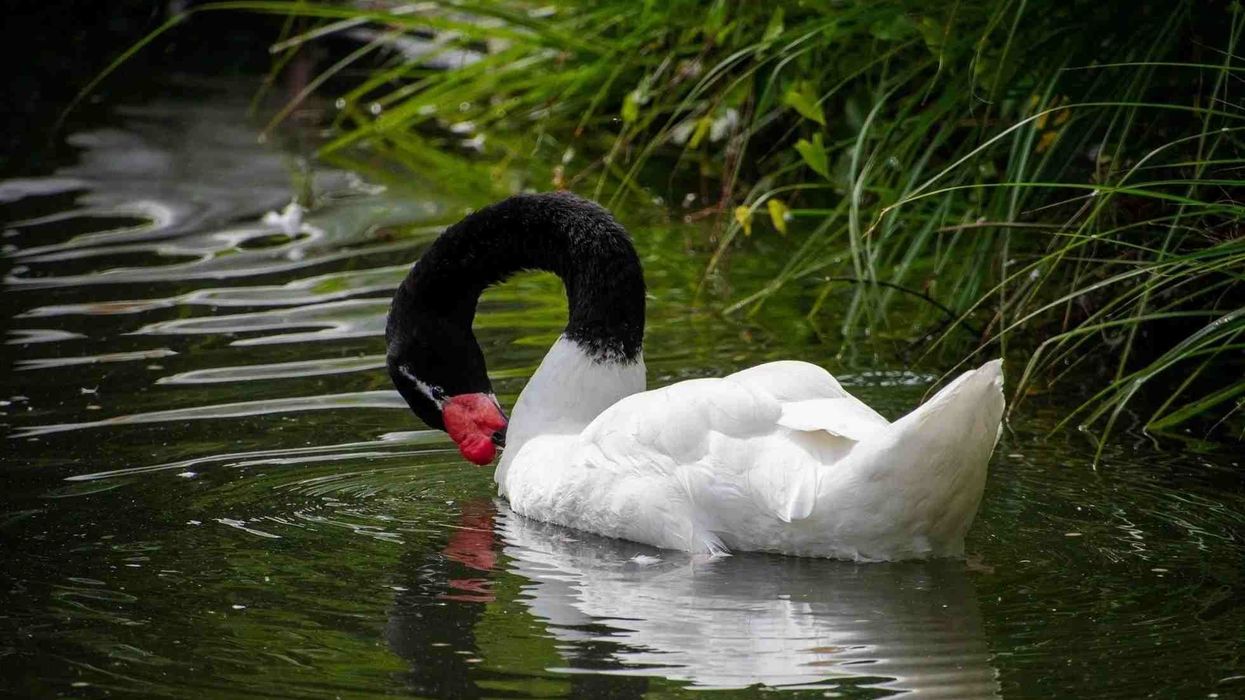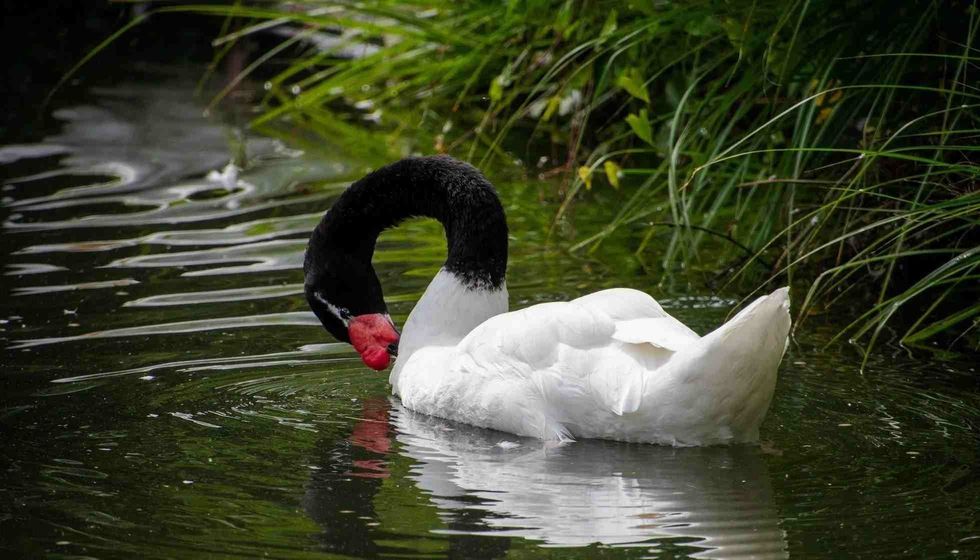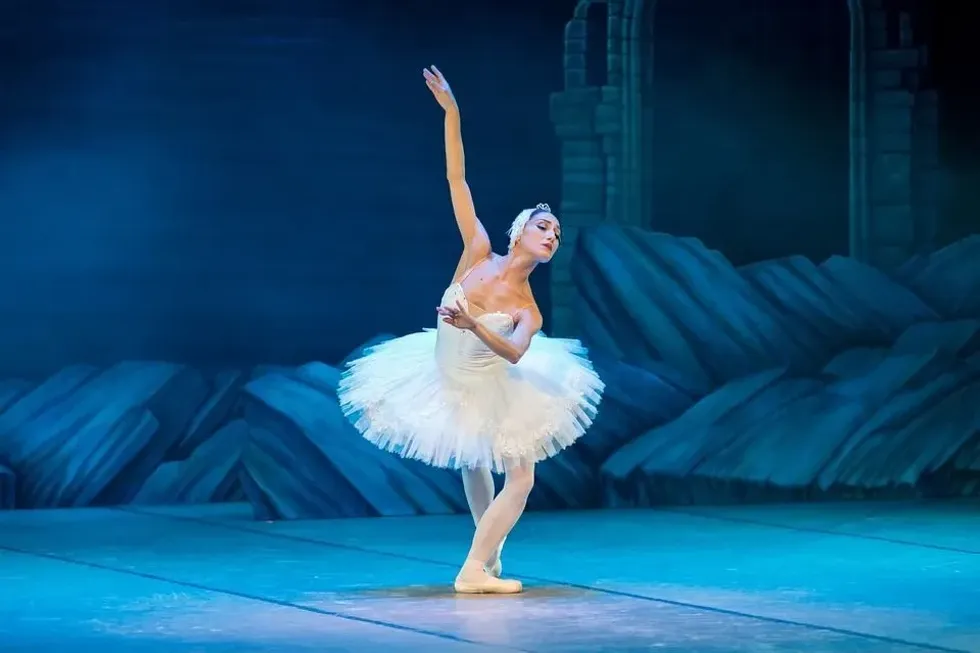The black-necked swan (scientific name: Cygnus melancoryphus) is the largest waterfowl in South America. Native to the continent, the black-necked swan bird inhabits freshwater marshes, lagoons, inland lakes, estuaries, and the shallow coastal regions along the Pacific Ocean.
They migrate to the north of their range to Bolivia, Paraguay, and southern Brazil during winters. Unmistakable and with an appearance in total agreement with its name, the black-necked swans have a white body contrasting greatly with the black head and neck.
The male and female Cygnus melancoryphus (black-necked swan) birds mate for life and have a soft musical whistle which they let out repeatedly when threatened.
In addition, the black-necked swan males and females exhibit a unique triumphing ceremony during the breeding season - a behavior characterized predominantly by the melodious whistle call. These birds feed on aquatic plants and vegetation such as weeds, algae, as well as aquatic invertebrates, and fish.
The black-necked swan population is stable at a global level and is quite common and widespread throughout its natural habitat in South America.
Interested in discovering more about the black-necked swan? Black-necked swans are indeed intriguing, and you can learn more about them right here!
You can also check interesting facts about the coscoroba swan and black swan.
Black-Necked Swan Interesting Facts
What type of animal is a black-necked swan?
Black-necked swans (Cygnus melancoryphus/Cygnus melanocoryphus) are swan or waterfowl species of the family Anatidae.
What class of animal does a black-necked swan belong to?
Black-necked swans belong to the class Aves which includes all birds.
How many black-necked swans are there in the world?
The total population size of the black-necked swan is not available. However, the species has a widespread distribution throughout its range and has a stable global population, according to the International Union for Conservation of Nature (IUCN) Red List of Threatened Species.
Where does a black-necked swan live?
The black-necked swan biome includes aquatic habitats such as lagoons, freshwater marshes, river basins, swamps, estuaries, shallow inland lakes, and sheltered coastal areas. The species is particularly common in waters abundant with submerged aquatic plants and vegetation.
What is a black-necked swan's habitat?
The black-necked swan habitat is restricted to the lake shores, lagoons, and freshwater marshes of southern coastal South America. The black-necked swan range stretches from Patagonia, Falkland Islands, and Tierra del Fuego in southern South America to Uruguay and central Chile in the further north.
In winter, the species migrates north to southern Brazil, Bolivia, and Paraguay. These birds are common in waters rich with submerged aquatic plants and can be found from sea level to elevations of up to 3,937 ft (1,200 m).
Who do black-necked swans live with?
With regard to the black-necked swan personality and behavior, it can be said that the species is highly social in nature and may be found in loose groups. Outside the breeding season, these birds form mating pairs and become very territorial.
Even though these animals exhibit gregarious behavior around their own kind, they tend to be cautious around humans and will usually hide amidst surrounding vegetation. Swan parents are even known to panic, abandon their eggs, and flee at the sight of humans.
How long does a black-necked swan live?
In their natural habitat, the maximum lifespan of this swan with a black neck is about 30 years. The species is known to live for up to 20 years in captivity.
How do they reproduce?
The breeding season of the black-necked swans extends from July to August and sometimes late into the autumn months, with the species breeding as many as thrice in one season.
The male and female birds mate for life, but if one of the partners dies, the surviving mate will find a new partner.
Before the breeding pairs are established, the male and the female engage in a pre-mating triumphing ceremony; during this ritual, the male bird attacks its rival suitor and returns to its potential female partner to exhibit elaborate courtship gestures.
Breeding males and females swim around each other, perform different postures by dipping their neck and head into the water and give out the typical black-necked swan call.
The breeding nest is made up of aquatic plants and vegetation and is built around the edges of water bodies by both the male and female of a pair. The female bird lays a clutch consisting of four to eight cream-colored eggs, which undergo incubation for 34-36 days.
The female alone does the incubation. After the incubation period is over, the eggs of the waterfowl hatch, and the cygnets (young swans) that emerge are covered with grayish-white downy feathers.
After hatching, the cygnets take about 10 weeks to fledge and are taken care of by both parents.
The parents provide food to the cygnets and protect them from predators. The cygnets become mature within two years of hatching but do not form pairs until they are three years old.
What is their conservation status?
According to the evaluation of the International Union for Conservation of Nature (IUCN) Red List of Threatened Species, the black-necked swans have a Least Concern status with a globally stable population.
Black-Necked Swan Fun Facts
What do black-necked swans look like?
Black-necked swans have a body of white feathers and a prominent, long black neck and head. They have an unmistakable white stripe behind the eyes. In addition, the head and neck may be speckled with white.
A double-lobed, bright red knob or caruncle is present at the base of the bluish-gray bill where it meets the head. The birds have pointed wings with short, pink legs, and the wings are covered in white feathers. The hind toe is elevated.
Young swans or cygnets are dull with light-brownish-gray coat color. The bills and feet are black. They develop contrasting black neck and white bodies in their second year of life.
How cute are they?
No doubt, the cygnets are very cute and adorable due to their sheer size. Adults, on the other hand, are more beautiful than cute. The slender, long black neck and white body further add a touch of elegance to the animals.
How do they communicate?
When it comes to vocal communication, black-necked swans give out soft and wheezy musical whistles that do not carry far. These calls are used during the breeding season, or when threatened by intruders, and while in flight as a contact call.
Physical gestures such as head dipping and wing flapping are part of the visual modes of communication of the animals.
How big is a black-necked swan?
Black-necked swan length ranges between 40-49 in (102-124 cm). Females are relatively smaller than males. Black-necked swans are slightly smaller than the black swan (Cygnus atratus) of Australia while being bigger than swan gooses.
How fast can a black-necked swan move?
Black-necked swans are one of the fastest swan species that can reach speeds of up to 50 mph (80 kph) during flight.
How much does a black-necked swan weigh?
The weight of a black-necked swan can range between 7.7-14.8 lb (3.5-6.7 kg).
What are the male and female names of the species?
Black-necked swan males are called cobs, and females are called hens.
What would you call a baby black-necked swan?
A baby black-necked swan is called a cygnet.
Are they rare?
No, black-necked swans are not rare. In fact, they are quite common and widespread in their geographical range.
Did you know...
Swan parents are known to carry the young on their backs. While both parents are involved in it, it is usually the male who takes on much of this responsibility so that the new mother can focus on feeding and recover the weight lost during the incubation period.
Black-necked swans are primarily vegetarians and feed on pondweeds, stoneworts, wild celery, milfoil, and other waterweeds. Their diet may also include insects and occasionally fish or frog eggs.
While kelp gulls predate on the swan's eggs in the Falkland Islands, the Southern Caracaras like the chimango caracaras and crested caracaras are a threat to cygnets and eggs in Chile.
What is the red skin on the beak of a black-necked swan?
The red skin or the red knob at the base of the bill of black-necked swans is known as the caruncle.
There are several propositions as to the function of these organs; they are ornamental add-ons that the male uses to attract females during the breeding season, they may be associated with genes imparting disease resistance, or they may help in regulating the body temperature in birds of tropical areas.
What's unique about the black-necked swan?
Black-necked swan adaptations are pretty unique. For instance, its extremely short legs make it an excellent swimmer while at the same time causing inconvenience walking on land.
In spite of having small wingspans, this swan species has one of the highest flight speeds. Further, the bill of this bird is adapted to suit its aquatic diet. The black-necked swan diet mainly comprises aquatic plants.
Hence, the birds have developed a jagged bill to filter feed nutrients from the water. Further aiding in the bird's diet is its rough tongue that helps in gripping the slippery aquatic vegetation it feeds on.
Here at Kidadl, we have carefully created lots of interesting family-friendly animal facts for everyone to discover! For more relatable content, check out these mute swan facts and trumpeter swan facts for kids.
You can even occupy yourself at home by coloring in one of our free printable black necked swan coloring pages.








